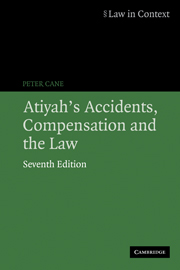Book contents
- Frontmatter
- Contents
- Preface
- List of abbreviations
- List of tables
- Table of legislation
- Table of cases
- Part One The Issues in Perspective
- Part Two The Tort System in Theory
- Part Three The Tort System in Operation
- Part Four Other Compensation Systems
- 11 First-party insurance
- 12 Compensation for criminal injuries
- 13 The social security system
- 14 Other forms of assistance
- Part Five The Overall Picture
- Part Six The Future
- Index
13 - The social security system
Published online by Cambridge University Press: 05 June 2012
- Frontmatter
- Contents
- Preface
- List of abbreviations
- List of tables
- Table of legislation
- Table of cases
- Part One The Issues in Perspective
- Part Two The Tort System in Theory
- Part Three The Tort System in Operation
- Part Four Other Compensation Systems
- 11 First-party insurance
- 12 Compensation for criminal injuries
- 13 The social security system
- 14 Other forms of assistance
- Part Five The Overall Picture
- Part Six The Future
- Index
Summary
Foundations of the social security system
Workers' compensation
Although the origins of the modern social security system have been traced to the poor law of the Elizabethan age, it is sufficient for our purposes (since we are concerned primarily with disability) to look no further back than 1897 when the first Workmen's Compensation Act was passed. In the nineteenth century the tort system rarely provided any compensation to the victim of an industrial injury because of the three defences which the courts had evolved for the protection of employers – namely common employment, denying liability for the negligence of a fellow worker; contributory negligence, denying liability where the worker was partly responsible for their own injuries; and volenti non fit injuria (assumption of risk) which (as then interpreted) denied liability for injuries occurring from a known and obvious risk. However, in 1880 Parliament passed the Employers' Liability Act, which restricted the scope of the doctrine of common employment; and in 1891 the House of Lords limited the availability of the defence of volenti. Furthermore, between 1878 and 1901 a stream of new factory legislation emerged dealing with the health and safety of workers, and the common law responded with the creation of the action for breach of statutory duty.
But these developments were dwarfed in significance by the enactment in 1897 of the Workmen's Compensation Act, which broke away entirely from the common law principle that liability must be based on fault, and conferred on a worker (orthe worker's dependants) a right to compensation for any accident ‘arising out of and in the course of employment’.
- Type
- Chapter
- Information
- Atiyah's Accidents, Compensation and the Law , pp. 328 - 362Publisher: Cambridge University PressPrint publication year: 2006

